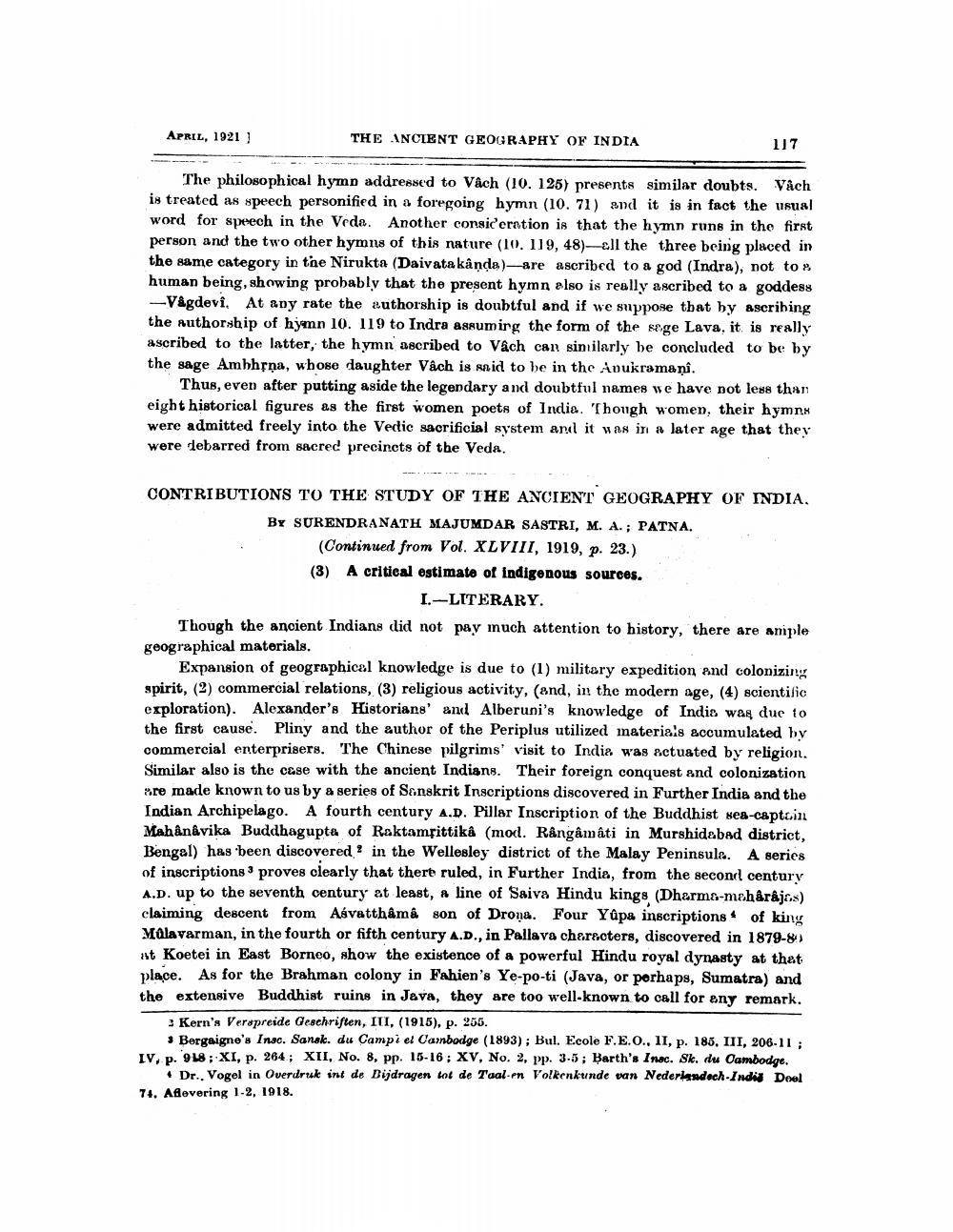________________
APRIL, 1921]
THE ANCIENT GEOGRAPHY OF INDIA
117
The philosophical hymn addressed to Vâch (10. 125) presents similar doubts. Vâch is treated as speech personified in a foregoing hymn (10. 71) and it is in fact the usual word for speech in the Veda. Another consideration is that the hymn runs in the first person and the two other hymns of this nature (10. 119, 48)-all the three being placed in the same category in the Nirukta (Daivata kânda)-are ascribed to a god (Indra), not to human being, showing probably that the present hymn also is really ascribed to a goddess -Vagdevi. At any rate the authorship is doubtful and if we suppose that by ascribing the authorship of hymn 10. 119 to Indra assuming the form of the sage Lava, it is really ascribed to the latter, the hymn ascribed to Vâch can similarly be concluded to be by the sage Ambhṛṇa, whose daughter Vâch is said to be in the Anukramani.
Thus, even after putting aside the legendary and doubtful names we have not less than eight historical figures as the first women poets of India. Though women, their hymns were admitted freely into the Vedic sacrificial system and it was in a later age that they were debarred from sacred precincts of the Veda.
CONTRIBUTIONS TO THE STUDY OF THE ANCIENT GEOGRAPHY OF INDIA. BY SURENDRANATH MAJUMDAR SASTRI, M. A.; PATNA. (Continued from Vol. XLVIII, 1919, p. 23.)
(3) A critical estimate of indigenous sources.
I.-LITERARY.
Though the ancient Indians did not pay much attention to history, there are ample geographical materials.
Expansion of geographical knowledge is due to (1) military expedition and colonizing spirit, (2) commercial relations, (3) religious activity, (and, in the modern age, (4) scientific exploration). Alexander's Historians' and Alberuni's knowledge of India was due to the first cause. Pliny and the author of the Periplus utilized materials accumulated by commercial enterprisers. The Chinese pilgrims' visit to India was actuated by religion. Similar also is the case with the ancient Indians. Their foreign conquest and colonization are made known to us by a series of Sanskrit Inscriptions discovered in Further India and the Indian Archipelago. A fourth century A.D. Pillar Inscription of the Buddhist sea-captain Mahânâvika Buddhagupta of Raktamrittikâ (mod. Rângâmâti in Murshidabad district, Bengal) has been discovered in the Wellesley district of the Malay Peninsula. A series of inscriptions proves clearly that there ruled, in Further India, from the second century A.D. up to the seventh century at least, a line of Saiva Hindu kings, (Dharma-mehârâjas) claiming descent from Asvatthâmâ son of Drona. Four Yûpa inscriptions of king Mûlavarman, in the fourth or fifth century A.D., in Pallava characters, discovered in 1879-8 at Koetei in East Borneo, show the existence of a powerful Hindu royal dynasty at that place. As for the Brahman colony in Fahien's Ye-po-ti (Java, or perhaps, Sumatra) and the extensive Buddhist ruins in Java, they are too well-known to call for any remark.
Kern's Verspreide Geschriften, III, (1915), p. 255.
Bergaigne's Insc. Sansk. du Campi el Cambodge (1893); Bul. Ecole F.E.O., II, p. 185. III, 206-11; IV, p. 918; XI, p. 264; XII, No. 8, pp. 15-16; XV, No. 2, pp. 3-5; Barth's Insc. Sk. du Cambodge. Dr.. Vogel in Overdruk int de Bijdragen tot de Taal-en Volkenkunde van Nederlandech-India Doel 74. Aflevering 1-2, 1918.




